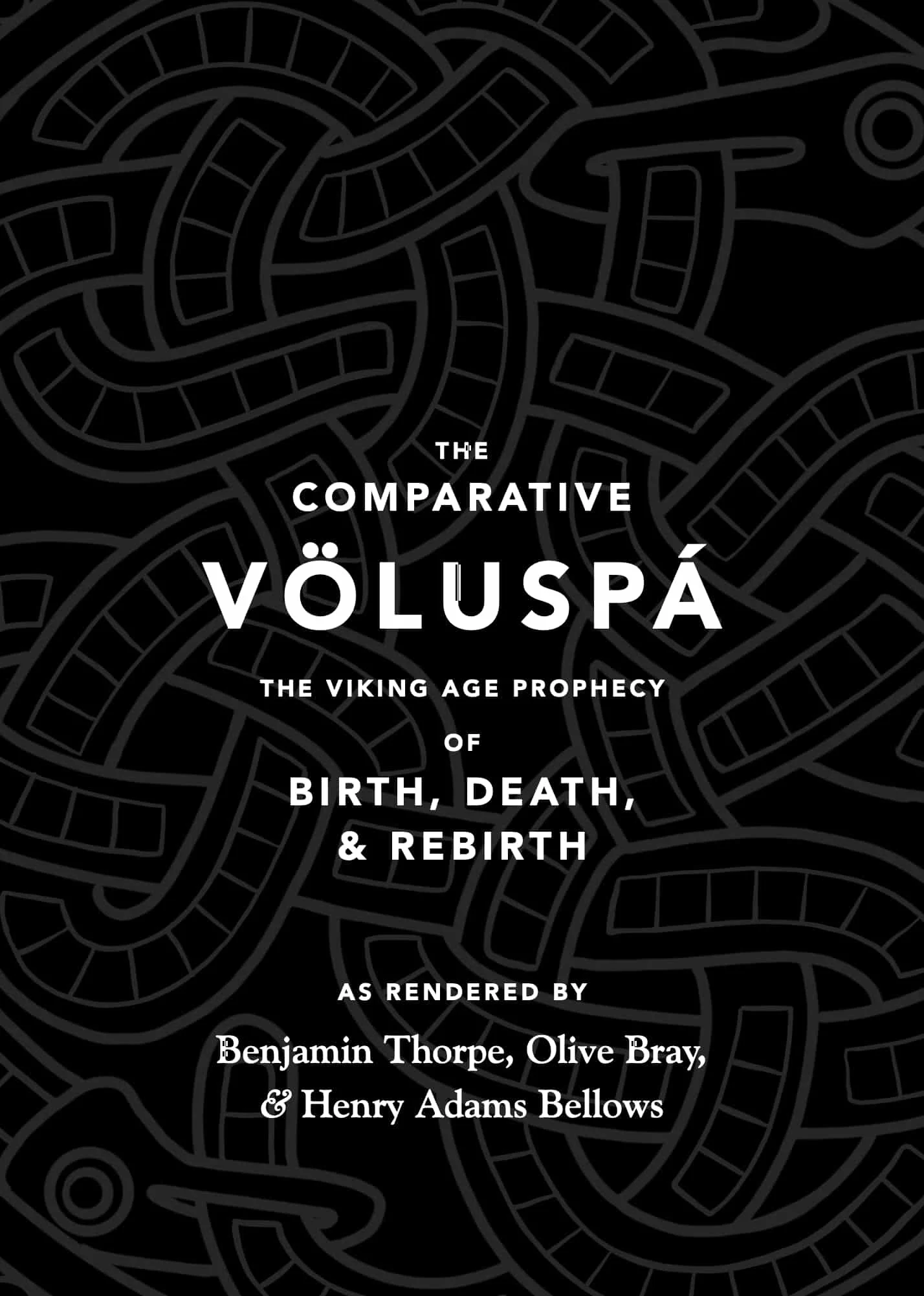Beyond The Little Book of Viking Age Symbols:
Expanded Reading & References
Maintained by Joseph S. Hopkins for Hyldyr, December 2023. Updated Februrary 2025. Special thanks to Ann Sheffield.
The present resource serves as an extension to the following Hyldyr publication:
For readers without a copy, please note that (despite the title) the book contains discussion and depictions of imagery related to but exterior to Viking Age Scandinavia, containing extensive discussion about symbolism used by for example the Anglo-Saxons and continental Germanic-speaking peoples. It also includes discussion of symbols thought to be ancient but of much more recent origins.
On this web page we provide an expanding roster of resources readers will find useful for further research. To make matters easiest for most readers, we have wherever possible focused on modern and (mostly) English language publications.
For a general discussion on relevant ‘getting started’ guide and translations of primary sources, see “Getting Started with Norse Mythology” at Mimisbrunnr.info, and for a list of relevant digital collections, see “Museum Resources: Digital Collection Catalogues” at Mimisbrunnr.info.
Index
Click any of the following links to go directly to the entry
Ancient symbols
Contemporary symbols
Ancient Symbols
This section includes both visual and literary symbols found in not only the Viking Age but also among related peoples, such as the continental Germanic-speaking peoples and the Anglo-Saxons.
Antler
Image item: “sceptre; whetstone”. The British Museum. Web.
Hopkins, Joseph S. 2020. "Antlers & Stag". Mimisbrunnr.info. Web.
Apple
Hopkins, Joseph S. 2020. "Apple & Apple Tree". Mimisbrunnr.info. Web.
Boar
Kovárová, Lenka. 2011. "The Swine in Old Norse Religion and World View". MA Thesis. University of Iceland. Web.
Cat
Image item: “C55000/224.A.1”. National Museum of Norway. Web. (Scroll down for many images)
Petersen, Peter Vang. 2023. "Wheels for Freyja's Chariot? Wheel-shaped Pendants from the Viking Age" in Leszek Gardeła, Sophie Bønding, & Peter Pentz (eds.). The Norse Sorceress: Mind and Materiality in the Viking World, p. 463-468. Oxbow Books.
Pezzoli, Luciano. 2023. "The Oseberg Wagon: Reopening the Case" in Leszek Gardeła, Sophie Bønding, & Peter Pentz (eds.). The Norse Sorceress: Mind and Materiality in the Viking World, p. 239-255. Oxbow Books.
Toplak, Matthias. 2019. "The Warrior and the Cat: A Re-Evaluation of the Roles of Domestic Cats in Viking Age Scandinavia". Current Swedish Archaeology 27, p. 213-245.
Drinking horn
Hofman, Anne. 2015. “Drinking Horns in Old Norse Culture: A Tradition Under Examination”. Analecta Archaeologica Ressoviensia, vol. 10, p. 241–270.
Genitals
Image item: “Rällingestatyetten”. Swedish History Museum. Web.
Hair
Image item: “Valkyrier fra Tissø”. National Museum of Denmark. Web.
Lincoln, Bruce. 1977. “Treatment of Hair and Fingernails among the Indo-Europeans”. History of Religions, vol. 16, no. 4, p. 351-362.
Horned helmet
Image item: “Mount, Unique ID: BERK-DB4E15”. National Antiquities Scheme. Web.
Langer, Johnni. 2021. “Horned, barbarian, hero: the visual invention of the Viking through European art”. Scandia Journal of Medieval Norse Studies. Vol. 4, 2021, p. 131-180.
Ward, Elisabeth Ida. 2001. “Viking Pop Culture on Display: The Case of the Horned Helmets”. Material Culture Review Revue De La Culture Materielle.
Vandkilde, Helle, Valentina Matta, Laura Ahlqvist, & Heide W. Nørgaard. 2022. “Anthropomorphised warlike beings with horned helmets: Bronze Age Scandinavia, Sardinia, and Iberia compared”. Praehistorische Zeitschrift, vol. 97, no. 1, p. 130-158.
Zawadzka, Anna. 2011 [2009]. “Gallic Horned Helmets on the Roman Republican Coinage”. Archeologia. Rocznik Instytutu Archeologii i Etnologii Polskiej Akademii Nauk 60, 2009 [2011], 35-43, Pl. II-III.
Horse
Armstrong Oma, Kristin. 2022. “The Steed Knew Well His Master Was Slain: Human-Horse Relationships in the Age of Heroes— The Scandinavian Iron Age" in Gala Argent & Jeannette Vaught (eds.). The Relational Horse: How Frameworks of Communication, Care, Politics and Power Reveal and Conceal Equine Selves, p. 77-89. Brill.
Gjessing, Gutorm. 1943. “Hesten i førhistorisk kunst og kultus”, in Viking, 7, 1943, p. 5-144.
Henderson, Rebecca. 2022. “Hrafn ok Sleipnir, hestar ágætir: Horses of the Medieval North” in Anastasija Ropa & Timothy George Dawson (eds.). Echoing Hooves: Studies on Horses and Their Effects on Medieval Societies, p. 49-56. Brill.
Pedersen, Anne & Merethe Schifter Bagge. 2021. Horse and Rider in the Late Viking Age: Equestrian Burial in Perspective. Aarhus University Press.
Mask
Image item: “Århus-runesten 3”. National Museum of Denmark. Web.
Gunnell, Terry. “Introduction” in Ed. Terry Gunnell. Masks and Mumming in the Nordic Area. Acta academiae regiae Gustavi Adolphi 98. Kungl. Gustav Adolfs Akademien för svensk folkkultur.
Mead
Image item A: “Det længste guldhorn fra Gallehus (kopi)”. National Museum of Denmark. Web.
Image item B: “Valkyrie fra Nygård”. National Museum of Denmark. Web.
Buckley, James. 2015. Inspiration and Inebriation: Transformative Drinks in Old Norse Literature. MPhil Dissertation, University of Cambridge.
Eriksen, Stefka G.. 2018. “‘Liquid Knowledge’ in Old Norse Literature and Culture.” Viator 49.2: 169–197.
Grage, Joachim. 2001. “Der Vergessenheitstrank: Zur Funktion der magischen Amnesie in der Nibelungenüberlieferung.” Arbeiten zur Skandinavistik 14: Arbeitstagung der deutschsprachigen Skandinavistik, 1.–5.9.1999 in München, ed. Annegret Heitman, 499–507. Frankfurt am Main: Lang.
Hopkins, Joseph S. 2020. “Bee & Honey”. Mimisbrunnr.info. Web.
Nelson, Max. 2005. The Barbarian’s Beverage: A History of Beer in Ancient Europe. London: Routledge.
Nordland, Odd. 1969. Brewing and Beer Traditions in Norway: The Social Anthropological Background of the Brewing Industry. Oslo: Universitetsforlaget.
Orton, Peter. 2007. “Spouting Poetry: Cognitive Metaphor and Conceptual Blending in the Old Norse Myth of the Poetic Mead.” In Constructing Nations, Reconstructing Myth: Essays in Honour of T. A. Shippey, edited by Andrew Wawn, Graham Johnson, and John Walter, 277–300. Turnhout: Brepols.
Quinn, Judy. 2010. “Liquid Knowledge: Traditional Conceptualisations of Learning in Eddic Poetry.” In Along the Oral-Written Continuum: Types of Texts, Relations and Their Implications, edited by Slavica Ranković, Leidulf Melve, and Else Mundal, 183–226. Turnhout: Brepols.
Sheffield, Ann. 2023. “Men Who Brew: Masculinity and the Production of Drink in Medieval Icelandic Literature.” Scandinavian Studies 95.1: 85–107.
Stephens, John. 1972. “The Mead of Poetry: Myth and Metaphor.” Neophilologus 56 (3): 259–68.
Svava Jakobsdóttir. 2002. “Gunnlǫð and the Precious Mead.” Translated by Katrina Attwood. In The Poetic Edda: Essays on Old Norse Mythology, edited by Paul Acker and Carolyne Larrington, 27–57. New York: Routledge.
Unger, Richard W. 2004. Beer in the Middle Ages and the Renaissance. Philadelphia: University of Pennsylvania Press.
Viklund, Karin. 2011. “Beer Brewing in Medieval Sweden: Archaeobotanical and Documentary Evidence.” In Processing, Storage, Distribution of Food: Food in the Medieval Rural Environment, edited by Jan Klápště and Petr Sommer, 235–43. Turnhout: Brepols.
Zimmerman, Ute. 2014. “Bier, Runen und Macht: Ein Formelwort im Kontext.” Futhark: International Journal of Runic Studies 5: 45–64.
Raven
Image item: “Tre brakteater”. National Museum of Denmark. Web.
Gräslund, Annie-Sofie. "Wolves, serpents, & birds: Their symbolic meaning in Old Norse belief" in Anders Andrén, Kristina Jennbert, & Catharina Raudvere (eds). Old Norse Religion in Long-Term Perspectives, p. 124-129.
Gotfredsen, Anne Birgitte. 2014. “Birds in Subsistence and Culture at Viking Age Sites in Denmark”. International Journal of Osteoarchaeology 24(3).
Rune (Historic)
Beck, Wolfgang. 2021. "Reading Runes in Late Medieval Manuscripts" in Mindy LacLeod, Marco Bianchi, and Henrik Williams (eds). Proceedings of the Eighth International Symposium on Runes and Runic Inscriptions, Nyköping, Sweden, 2–6 September 2014, p. 225-232. Uppsala.
Düwel, Klaus. 2004. "Runic" in Brian Murdoch and Malcolm Read (eds). Early Germanic Literature and Culture, p. 121-141. Camden House.
Kindy, David. 2021. “Runes Found on Seventh-Century Cow Bone Could Change Slavic History”. Smithsonian Magazine. May 19, 2021.
Looijenga, Tineke. 2020. "Germanic: Runes" in Palaeohispánica 20, p. 819-853. Institucion Fernando el Catolico de la Excma. Diputacion de Zaragoza.
Page, R.I. 1999. An Introduction to English Runes. Boydell Press.
MacLeod, Mindy & Bernard Mees. 2006. Runic Amulets and Magic Objects. Boydell Press.
Spurkland, Terje. 2005 [2001]. Norwegian Runes and Runic Inscriptions. Boydell Press
Serpent, Dragon, & Wyrm
Gardeła, Leszek. 2020. “Uncoiling the Serpent: Snake Figurines in the Viking Age.” Viking and Medieval Scandinavia 16, p. 27–61.
Gräslund, Annie-Sofie. "Wolves, serpents, & birds: Their symbolic meaning in Old Norse belief" in Anders Andrén, Kristina Jennbert, & Catharina Raudvere (eds). Old Norse Religion in Long-Term Perspectives, p. 124-129.
Johansen, Birgitta. 1997. Ormalur: Aspekter av tillvaro och landskap. Ph.D. thesis, Stockholms universitet. Stockholm Studies in Archaeology 14. (Summary is in English)
Ship
Image item: “C55000/1”. National Museum of Norway. Web.
Hopkins, Joseph S. & Haukur Þorgeirsson. 2011. "The Ship in the Field". RMN Newsletter, no. 3, p. 14-18.
Rabiega, Kamil & Zbigniew Kobylinski. 2018. "The symbolic role of boats and ships in pagan and Christian Medieval Northern Europe" in Louis Daniel Nebelsick, Joanna Wawrzeniuk, and Katarzyna Zeman-Wiśniewska (eds). Sacred space: contributions to the archaeology of belief. Institute of Archaeology, Cardinal Stefan Wyszyński University in Warsaw.
Spear
Image item: “C55000/1”. National Museum of Norway. Web.
Hopkins, Joseph S. & Haukur Þorgeirsson. 2011. "The Ship in the Field". RMN Newsletter, no. 3, p. 14-18.
Rabiega, Kamil & Zbigniew Kobylinski. 2018. "The symbolic role of boats and ships in pagan and Christian Medieval Northern Europe" in Louis Daniel Nebelsick, Joanna Wawrzeniuk, and Katarzyna Zeman-Wiśniewska (eds). Sacred space: contributions to the archaeology of belief. Institute of Archaeology, Cardinal Stefan Wyszyński University in Warsaw.
Swastika
Mees, Bernard. 2008. The Science of the Swastika. Central European University Press.
Sword
Image item: “Valkyriefigur fra Tjørnehøj, Hårby s.”. National Museum of Denmark. Web.
Ellis Davidson, Hilda. [1998] 1962. The Sword in Anglo-Saxon England. The Boydell Press.
Peirce, Ian G. 2002. Swords of the Viking Age. The Boydell Press.
Tree & Grove
Bintley, Michael D. J. 2015. Trees in the Religions of Early Medieval England. Boydell & Brewer.
Cusack, Carole M. 2011. The Sacred Tree: Ancient and Medieval Manifestations. Cambridge Scholars Publishing.
Dowden, Ken. 2002 [2000]. European Paganism: The Realities of Cult from Antiquity to the Middle Ages. Routledge.
Hooke, Della. 2010. Trees in Anglo-Saxon England: Literature, Lore and Landscape. The Boydell Press.
Hopkins, Joseph S. 2020. "Sacred Tree & Holy Grove". Mimisbrunnr.info. Web.
Thor’s Hammer/Mjölnir
Image item: “Thorshammer fra Rømersdal”. National Museum of Denmark. Web.
Beard, Katherine Suzanne. 2019. Hamarinn Mjǫllnir:The Eitri Database and the Evolution of the Hammer Symbol in Old Norse Mythology. University of Iceland.
Three & Nine
Gardeła, Leszek. 2022.“Miniatures with Nine Studs: Interdisciplinary Explorations of a New Type of Viking Age Artefact”. Fornvännen 117, p. 15-36.
Hopkins, Joseph S. 2020. "Numbers: Three & Nine". Mimisbrunnr.info. Web.
Valknut
Image item: “finger-ring”. The British Museum. Web.
Gardeła, Leszek. 2022.“Miniatures with Nine Studs: Interdisciplinary Explorations of a New Type of Viking Age Artefact”. Fornvännen 117, p. 15-36.
Hellers, Tom. 2012. Valknútr: das Dreiecksymbol der Wikingerzeit. Fassbaender. (German language)
Wolf
Gräslund, Annie-Sofie. "Wolves, serpents, & birds: Their symbolic meaning in Old Norse belief" in Anders Andrén, Kristina Jennbert, & Catharina Raudvere (eds). Old Norse Religion in Long-Term Perspectives, p. 124-129.
Contemporary SYMBOLS
In this section we examine contemporary symbols, including those often mistaken to be ancient.
Black Sun (Schwarze Sonne)
Note that this symbol is sometimes incorrectly referred to as “the Sonnenrad”. However, German Sonnenrad is just a common noun meaning ‘sun wheel’, a category often including symbols like the swastika and the Black Sun.
Hopkins, Joseph S. 2023. “Symbols Used by Nazi Germany, Neo-Nazis, and/or Far-Right Extremists”. Mimisbrunnr.info. Web.
Kirsten, John-Stucke & Daniele Siepe. Eds. 2022. Myths of Wewelsburg Castle: Facts and Fiction. Brill.
Teudt’s “Irminsul”
Hopkins, Joseph S. 2020. "Wilhelm Teudt's 'Irminsul' Symbol". Mimisbrunnr.info. Web.
“Valkyrie wing” tattoo
Item illustrated in place of likely copyrighted image: https://samlinger.natmus.dk/mom/object/558178 +
Scene from the film Max Payne discussing the tattoo motif (John Moore, 2008)
Web of Wyrd
Hopkins, Joseph S. 2020. "Web of Wyrd". Mimisbrunnr.info. Web.
Wolfsangel
Hopkins, Joseph S. 2023. “Symbols Used by Nazi Germany, Neo-Nazis, and/or Far-Right Extremists”. Mimisbrunnr.info. Web.
Röder, Christoph. 2014. “Vier karolingerzeitliche Grubenhäuser bei der Junkermühle, Stadt Münzenberg”. hessenARCHÄOLOGIE 2014.










